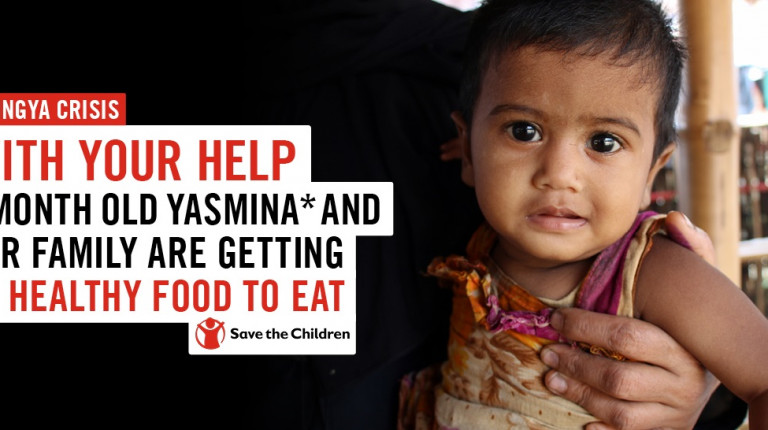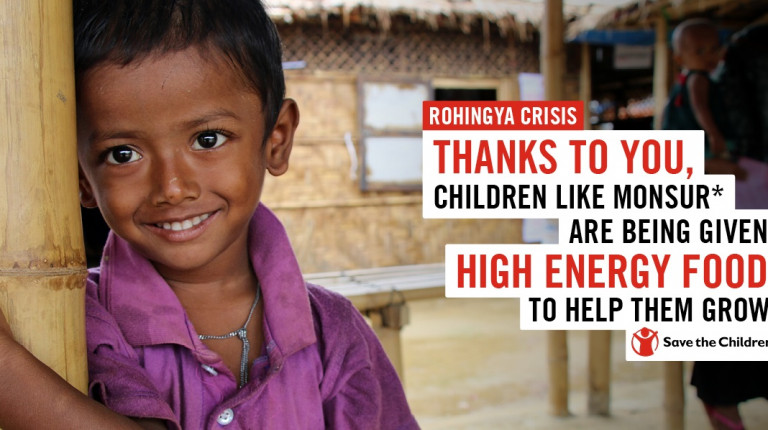My name is Daphnee Cook, and I’ve been working in the Rohingya refugee camps in Cox’s Bazar for just over a year now.
My job as the media and communications manager is to make sure people outside Bangladesh understand and care about what’s happening to Rohingya children and their families. This means I’ve spent the past year talking to literally hundreds of refugees and learning about their lives, both in the camps and back in Myanmar. It also means that if you’ve read about a Rohingya child through Save the Children, chances are, I was involved.
I take this job incredibly seriously, because I know that without this information, people like you – our donors, our friends – are less able to help.
I’m often asked how I’ve remained sane, particularly because the stories people tell are so filled with sorrow and suffering. There is no doubt, it is incredibly intense. The knowledge that the question “What brought you to Bangladesh?” might deliver you a story of terror, pain, sexual violence, loss and grief, fills your heart with dread.
The camps are also physically hard work. The heat, the smell, the mud. The humidity which can turn a plastic shelter into a sauna, so you need to stop an interview mid-way through because your sunscreen has
melted into your eyes and made them burn.
Yet while this has undoubtedly been the hardest year of my life, it’s also been the most inspiring. I’ve seen the depths of horror people can inflict on each other, but I’ve also seen the incredible positive impact that kind, caring people can have to relieve that suffering. My net feeling at the end of a year is one of hope.
The child that affected me the most is a little seven-year-old we named Aziz* (we change people’s names for their protection), who was shot in the thigh and had to have his entire leg amputated. He reminds me so much of my nephew. The thought of little Aziz waking up from his surgery and seeing his leg no longer there is sickening. How can people do this to each other? To little children? Even writing about this makes me angry.
But then, when I met Aziz, he was smiling and talking about how much he loves attending one of our child friendly spaces (CFS). “I love playing at the CFS,” he told me. “There are lots of toys and games. All the children who go to the CFS are my friends. I love them, and they love me.”
It’s honestly impossible to be sad when you hear stories like this. I thought I understood our impact when I was working in HQ, but it’s not the same as hearing it directly from people who have suffered so much.
Being here has removed any doubts I might have had about our impact. I see it every single day. It’s amazing.
While there is still so much that needs to be done – only half of children in the camps are accessing any kind of education, and people are still living in fragile and squalid conditions – when I speak with people in their homes, they often spontaneously tell me about Save the Children has improved their lives. “I took my sick son to the health post and now he is cured”. Or, “I’m so glad my daughter can go to the learning centre - we didn’t have that back in Myanmar”.
One woman who was found, unconscious, by my own communications team after a home birth and taken straight to hospital, told me bluntly a few months later: “I would have died without Save the Children.” How can you hear a story like that, and see her happy healthy chubby baby, and not be filled with joy?
I walk around the camps with a skip in my step, because I’m so proud to be part of this team.
Just two weeks ago, I found out our child protection colleagues had managed to get little Aziz a new leg. A brand-new prosthetic leg! He can now move around the camps without his crutches. Apparently, he now won’t stop moving, he’s so happy to be back on his feet. When I found this out, I actually did cry. It’s amazing what people can do, when we decide we want to help and make things better.
While we can’t change what happened to Rohingya children in Myanmar, we can change things that happen to them now. We hear the horror, but we also hear the beautiful things that are being done to help people get back on their feet.
Being part of the team that is changing lives every day has been the best experience of my life, and if I can communicate anything to you from here, it’s that your support has and is making children safer, happier and more hopeful.
What is the Rohingya Crisis all about?
Since August 2017, ethnic violence has forced 700,000 Rohingya to abandon their homes and flee for safety.
Families who made it across the border have set up home in the existing refugee camps in Cox’s Bazaar, Bangladesh, but conditions hundreds of thousands of people are crammed into a small area – creating a major risk of a disease outbreak. We have expanded our existing programmes to cope with the influx and are now operating 10 emergency health centres in the camps. Each one has a team of highly trained health professionals, including a medical doctor, psychosocial counsellor, paramedics and a midwife, who treat around 100 people every day.
We have also recently opened a new 20 bed Primary Health Care Centre (PHCC), with a structure that includes a maternity unity, a pharmacy, separate buildings for triage, inpatients and outpatients, and its own water tower and generator. The centre is the only one in the area to provide 24/7 in-patient care and will serve a population of 20,000 people, both Rohingya refugees and from the host community.
The centre runs 24 hours 7 days a week, and is also accessible for ambulances, which bring patients referred from facilities without capacity to keep patients overnight. This is a crucial step to enable our teams to treat those who have already experienced so much trauma, to ensure that mothers have safe and healthy pregnancies and babies are born healthy, protected from disease and illness that could otherwise be fatal.



